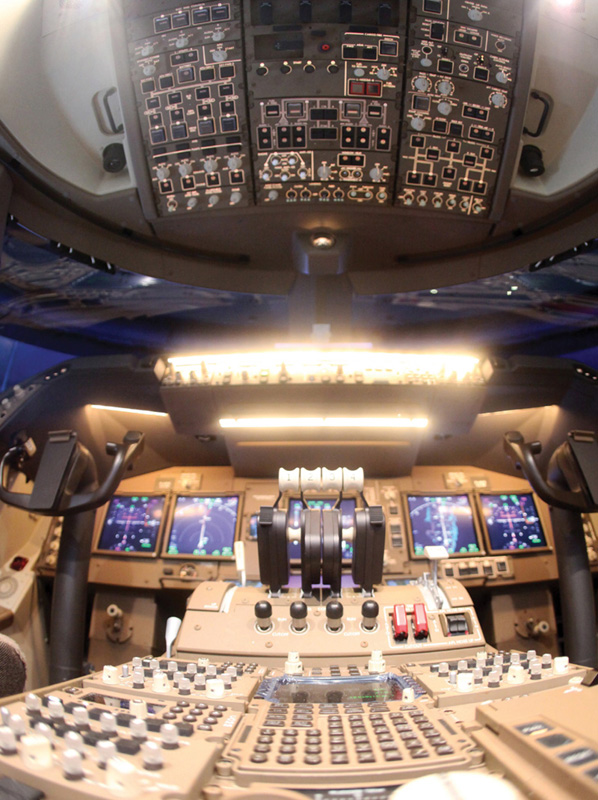
WHAT IT IS Taking control of a jumbo jet
WHY YOU WON’T DO IT The average pilot has dedicated many years to learning the art
Despite what the movies might suggest, to date there are no recorded instances of untrained civilians safely landing a commercial aircraft in an emergency. In 2012 a passenger did help to land a 747 Jumbo Jet at Dublin airport after the first officer became ill – but that passenger just happened to be an off-duty pilot. But you never know – so what if you do find yourself unexpectedly on the flight deck?
One bit of advice that will serve you better than any other: don’t panic! When you’re trying to bring a flying tin can full of people safely out of the sky and back to the ground, a clear mind is your best friend. Ensure that any incapacitated members of the crew are not leaning on the controls, take a seat and buckle up.
Your first aim should be to get the aircraft on a stable path. On the instrument panel, there will be an attitude indicator (sometimes labelled ‘artificial horizon’ or ‘gyro horizon’). This will tell you how the plane is oriented relative to the ground (the sky is a blue semicircle and the ground is brown, while the horizon is red), whether your wings (denoted by a pair of straight lines) are on an even keel, and if you’re maintaining, gaining or losing height. A nearby altimeter should give your absolute height on a dial, but that can wait till later – the important question is whether the plane is flying straight and level. If the answer is yes, that’s good – it probably means that the autopilot is on and the computers are keeping the plane on the proverbial straight and narrow.
If, however, the plane’s nose is pointing noticeably up or down, or if the wings seem to be doing their own thing, you’ll need to get hold of the yoke (the big joystick-cum-steering-wheel that should be directly in front of you). Gently pull back to bring the nose up, push forward to descend, and pull to the left or right to balance the wings.
Once the immediate crisis is over, get professional help as soon as possible. Locate the hand-held radio, push the PTT (Press to Talk) button and say ‘Mayday’ three times. Then release the PTT button and await a response. If there is no immediate answer, set the radio frequency to 121.5 MHz. When you receive a response, explain your unenviable situation – make sure they understand that your previous aviation experience is limited to Microsoft Flight Simulator, and that you could do with a little bit of help.
Beneath the radio, there may be a transponder to help air traffic control to locate you. Set the dials to or type in the number ‘7700’, which is a standard emergency call. An airport flight controller will do all they can to talk you through the steps to secure a safe landing. Listen to what they have to say and answer all their questions as accurately and concisely as possible. Don’t get flustered. Ideally, a suitable expert will soon be on the line, working in unison with air traffic control to talk you through exactly what you need to do. In theory, it should now become a simple case of pushing the buttons and flicking the switches when they tell you to.
One of the many great things about modern jet airliners is that they can virtually land themselves, assuming the autopilot is on. The chances are that you will not have to do much at all until the plane is about 30 metres (100 ft) above the landing area. Locate the gear handle and engage the landing gear when you are told to. You will also be advised on how to adjust the slats and flaps to prepare for landing, and will need to manipulate the yoke as advised to bring the plane onto terra firma as smoothly as possible (though your passengers will probably forgive any stylistic shortcomings, given the circumstances).
Once you’re safely on the ground, the next challenge is stopping. Pull the throttles all the way back and step on the brakes (found at the top of the rudder pedals at your feet). The rudder pedals are also likely to have some control over the nosewheel on the ground, so you can use them to steer your way down the central line if the plane appears to be veering off the runway.
As the plane comes to a complete stop, you’ll probably see the lights of emergency vehicles racing up the runway to meet you and hear the relieved cheering and applause from the passenger section. See if you can locate an ‘ignition key’ in front of you. Turn it to shut down the engine, unbuckle yourself from the seat and go and bask in your moment of glory.